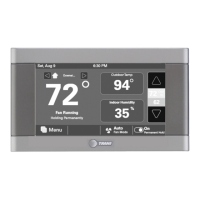Chapter 5 UCM communication link wiring and topology
42 BMTX-SVN01C-EN
Fiber-optic link signal loss budget
Every fiber-optic link has some signal loss (measured in decibels). Many
factors affect decibel loss, including:
• Length of fiber-optic cable
• Transmitter optical output power
• Operating wavelength
• Fiber attenuation
• Fiber bandwidth
• Receiver optical sensitivity
The decibel loss between any two devices is based on how well the termi-
nations or splices are made. A termination or splice can vary from
0.5–2 dB loss. A clean splice results in increased performance.
The fiber-optic modem supported by Trane has a power budget of 14 dB
(D1300) or 13 dB (D2300) between 32°F and 140°F (0°C and 60°C). This is
the acceptable temperature range specified for the BCU. The decibel loss
for conduit-rated fiber-optic cable (P/N 400-4002) is 3.75 dB/km (1 km =
3,280 ft). Precut fiber-optic cables and professionally spliced and/or termi-
nated cables should ensure minimal decibel loss.
To calculate the system loss, subtract the cable loss, splice loss, termina-
tor loss, and patch panel loss from the power budget. The example below
shows typical values for the UCM communication link using D1300.
power budget – system safety margin = available budget
14 dB – 3 dB = 11 dB (available budget)
available budget: 11 dB
cable loss: – 7.5 dB (1 km at 3.75 dB/km)
allowance for splice loss: – 1 dB (2 at 0.5 dB)
allowance for end connectors: – 1 dB (2 at 0.5 dB)
allowance for patch panel: – 1 dB (2 at 0.5 dB)
excess margin: = 0.5 dB

